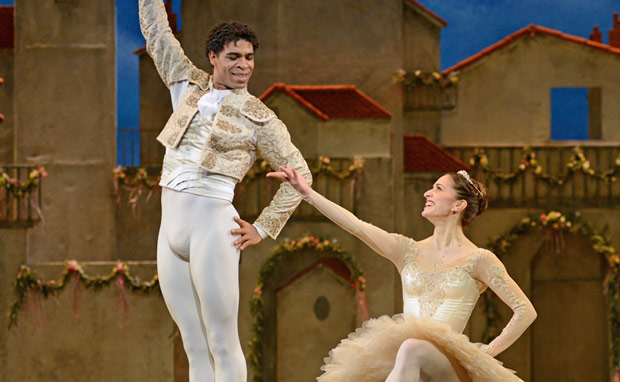
© Dave Morgan, courtesy the Royal Opera House. (Click image for larger version)
Royal Ballet
Don Quixote
London, Royal Opera House
25 November 2014
Gallery of pictures by Dave Morgan
www.roh.org.uk
New directors of old ballets are often tempted to make them relevant to today by stripping away dated conventions and substituting new ones: earthy peasants, drunken party-goers, crazed hallucinations in place of visions. Carlos Acosta has not gone too far in his 2013 version of Don Quixote, though he has tried to place the action in a more realistic Spanish working-class environment than the usual 19th century concoction.

© Dave Morgan, courtesy the Royal Opera House. (Click image for larger version)
The only aristocrat is the deluded Don, who sets out with his servant, Sancho Panza, on a mission to right the wrongs of the world. In a prologue similar to the one Rudolf Nureyev added to his account of the ballet, the old man is inspired by his ideal woman, Dulcinea. She appears to him as a ballerina all in white, rather like the Sylph haunting James in Bournonville’s La Sylphide. Don Quixote is going to conflate her with Kitri, the inn-keeper’s daughter, during most of the ballet.
Act I takes place in a village whose houses move around to suggest changes of scene. The locals bustle about, prone to erupting in noisy street dances. In their midst are just a few bravura ballet dancers on pointe, whose party pieces lack a plausible context. When Kitri (Marianela Nunez in the first cast) makes her entrance, flying exuberantly round the stage, she lacks support from her mates. She’s not one of them, unlike Giselle among fellow villagers who dance on pointe alongside her. Kitri’s two best girlfriends (Helen Crawford and Beatriz Stix-Brunell) seem similarly out of place in their lilac outfits. Who are they?

© Dave Morgan, courtesy the Royal Opera House. (Click image for larger version)
Once Acosta bounds in with his guitar as Basilio, the atmosphere heats up. He flirts with the girls, while Kitri flounces in indignation. The impact of their classically-based duets is dissipated by eager urchins turning cartwheels, then by cape-twirling matadors. The music needs to whip up excitement for spectacular solos, and then keep the momentum going. Martin Yates’s re-orchestration of Minkus’s jolly old score isn’t theatrically robust enough to stop the long first act sagging in between episodes.
The arrival of Don Quixote on a broken-down nag (no donkey for Sancho Panza) is diverting but then trails off. So does the entrance of Gamache, Kitri’s foppish suitor, who has a mobile home all to himself. After such a big build-up, the character has so little to do that even Bennet Gartside is unmemorable. Ryoichi Hirano stamps a sinister allure on the role of the star matador, Espada, making him a mafia-like capo of the corrida. Claire Calvert is feisty as his mistress, Mercedes, but she’s handicapped by a production problem. Her colouring and costume are too similar to Nunez’s, and she behaves in much the same way, flirting and flouncing. One such relationship is enough for Act I.
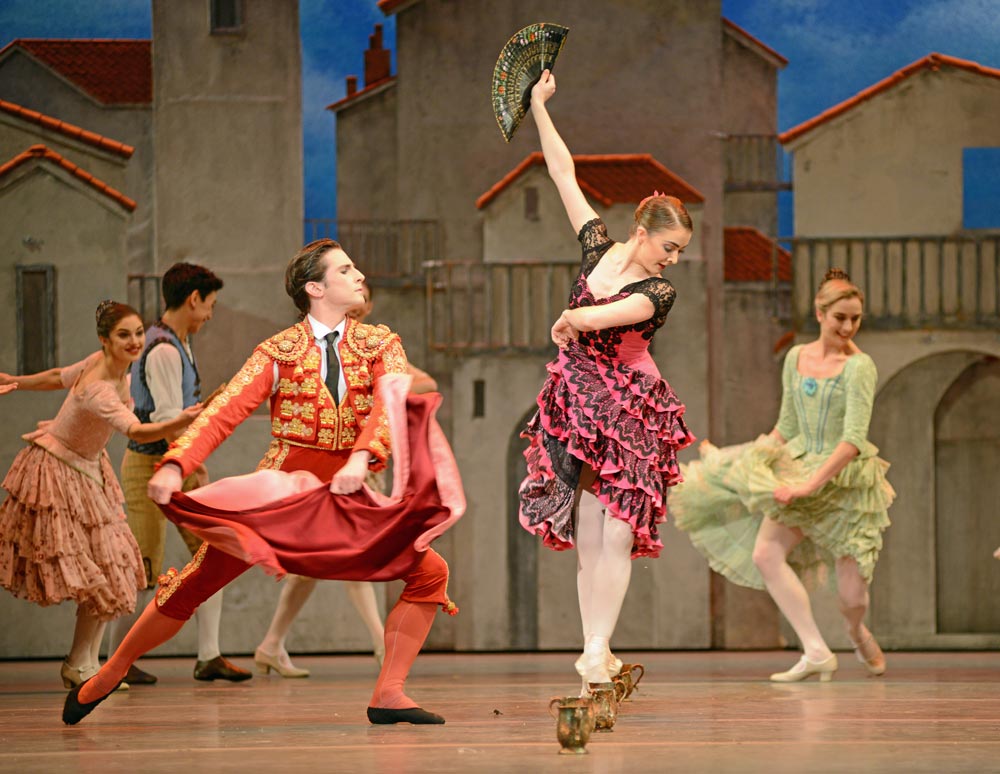
© Dave Morgan, courtesy the Royal Opera House. (Click image for larger version)
The first scene of Act II reveals the depth of feeling between Kitri and Basilio as they elope to a gypsy encampment. The partnership between Nunez and Acosta is like the shawl he wraps tenderly around her shoulders: warm, familiar, trustworthy. She has total confidence in him, valuing his generosity in caring for her more than himself. Both mischievous in the first act, they then develop a mature rapport that matters more than the technical feats they can accomplish.
Gypsy camps in British ballet are a nightmare, though this one is enlivened by the arrival of nomadic guitarists for a fandango around the fire. Kristen McNally is impressive as the principal gitana, dancing with gutsy abandon; Thomas Whitehead is an amiable ruffian, who cleans up nicely for his subsequent appearance with McNally in Act III.

© Dave Morgan, courtesy the Royal Opera House. (Click image for larger version)
Designer Tim Hatley’s colour palette is disturbing in Act II. Fair enough, maybe, for gypsies to favour garish purples, electric blues and brilliant greens but does the Don’s vision scene have to be in Technicolor shades of fuchsia? The backdrop is a tropical fantasy in magenta and heliotrope against an orange sunset. Hugh Vanstone’s lighting bathes pastel tutus in lurid violet, with bright spotlights for the three principals: Queen of the Dryads (Yuhui Choe) in yellow, Amour (Meaghan-Grace Hinkis) in powder blue and Kitri in pure white.

© Dave Morgan, courtesy the Royal Opera House. (Click image for larger version)
The three are presumably the Don’s fantasies of womanhood, with Kitri standing in for Dulcinea. Costume-wise, it would be helpful for Amour to be identified as Cupid rather than as a cute bridesmaid. Hinkis is charmingly skittish and Choe (almost as small) is regally remote as head dryad. They perform their tricky variations with admirable aplomb until their skills are outshone by Nunez’s master-class in what a ballerina can accomplish. Thanks to the repetitive choreography, she has to bring off identical sequences of steps and balances without faltering or speeding up. Nunez adds sex appeal to her insouciant control, sending the dithery Don into a trance of desire.
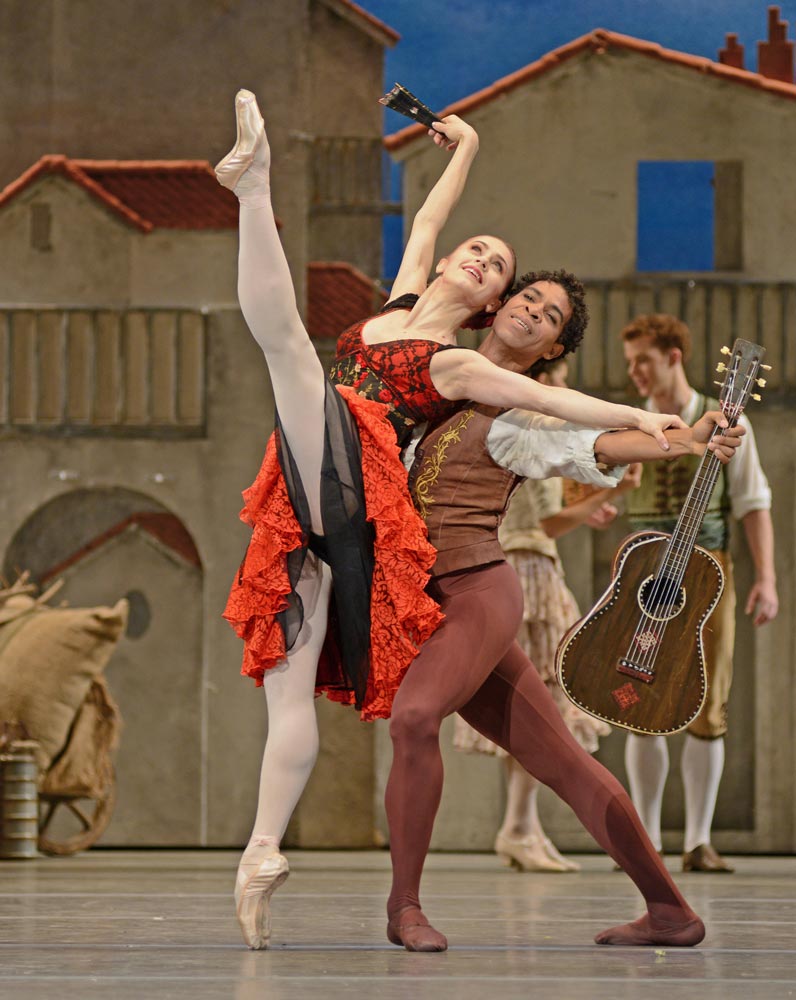
© Dave Morgan, courtesy the Royal Opera House. (Click image for larger version)
She is different again in Act III, at ease once more in Acosta’s arms when she’s not flicking her fan and showing off the precision of her feet in solo variations during the wedding celebrations. Attendant ladies should know better than to wave their fans on the sidelines when she is dancing – there is nothing more distracting for an audience. The last act is otherwise the most successfully staged of the three, bringing all the characters together for a heartwarming finale. Spurned Gamache even gets hitched to a compliant tavern girl — curiously enough, thanks to a last-minute cast change, to Dulcinea herself in the form of Christina Arestis. So everyone goes home happily. Yes, the Bolshoi production with non-stop dancing in every genre is greater fun. But Acosta’s version, with central performances like these, serves well enough.












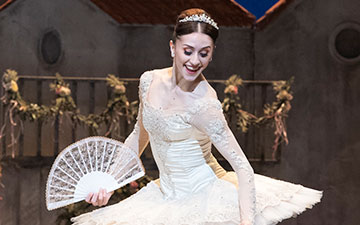
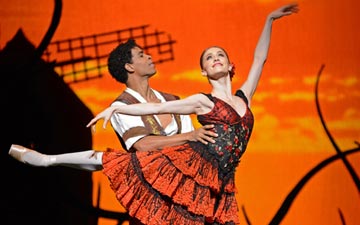
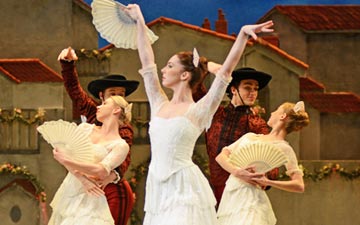
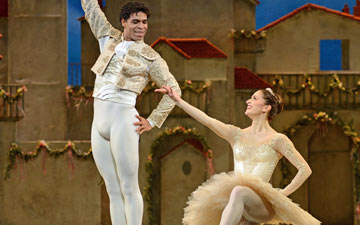
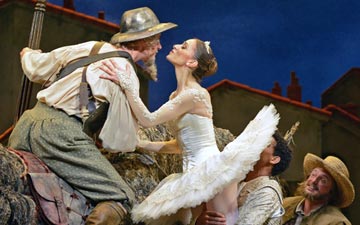
You must be logged in to post a comment.